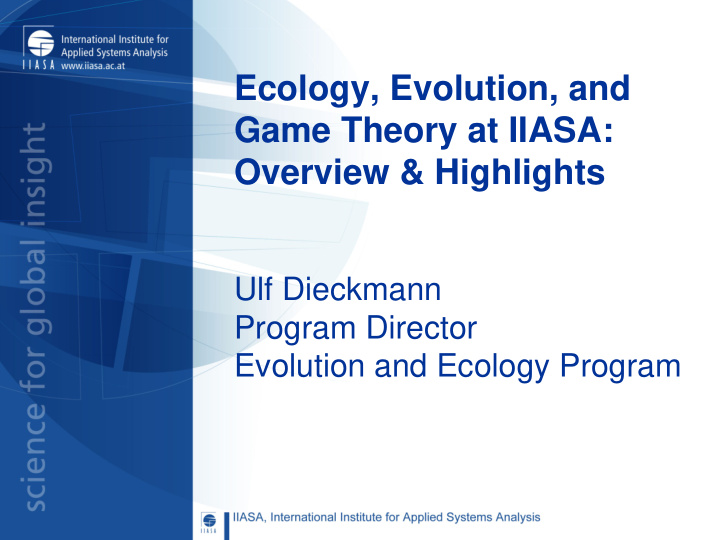



Ecology, Evolution, and Game Theory at IIASA: Overview & Highlights Ulf Dieckmann Program Director Evolution and Ecology Program
Early Highlights in Ecology Pest management models Adaptive management Resilience dynamics
Early Highlights in Game Theory Game theory, decision analysis Indirect reciprocity Methodological integration Replicator dynamics Win-stay, lose-shift Adaptive dynamics
Interdisciplinary Bridges Socio- Ecology Evolution economics Anthropogenic environmental impacts on fisheries, biodiversity, common goods, …
Ecology: Recent Highlights
Fishery Systems Management system Management Service Fishery policy and planning measures values Fishery management Fishery development Fishery research Socio-economic system Ecosystem services Fishers Supporting services Processors and retailers Regulating services Consumers Provisioning services Socio-economic environment Cultural services Natural system Target stock Non-target species Fishing Ecosystem Ecosystem embedding pressure status Physical environment
Management of Northeast Arctic Cod • Challenge Harvest-control rules are politically negotiated without support from quantitative modeling Yield-maximizing HCR (Johannesburg World • Innovation Our assessment Summit 2002) is process-based, couples an individual-based biological model with an economic Welfare-maximizing HCR Current HCR model, and accounts for three Profit-maximizing HCR alternative objectives • Results Current rule maximizes profit, while Adult biomass (1000 tonnes) alternative objectives lead to more aggressive exploitation Marine Policy 39:172 (2013)
Management of Barents Sea Capelin • Challenge Traditional 5 10 15 20 assessments account for 70% quotas, yields, and a single Minimum-size limit (cm) stakeholder group • Innovation Our assessment accounts for two regulations Status quo (quotas and minimum-size limits), four benefits (yields, profits, employment, and ecological impact), and five stakeholder groups 0 20 40 60 80 100 • Results Maximum joint Annual harvest proportion of unprotected stock (%) satisfaction is high, and is best achieved through minimum-size limits
Evolution: Recent Highlights
Collapse of Northern Cod • Challenge Stock collapsed in Size at 50% maturation 1992 and has not recovered probability at age 5 (cm) since; heavy exploitation favors earlier maturation at 80 smaller size 70 • Innovation Pioneering Moratorium 60 statistical and modeling 50 techniques 40 • Results We have 30 documented a 30% drop in 1975 1992 2004 size at maturation and Nature 428:932 (2004) showed that such evolutionary impacts of fishing are very slow and difficult to reverse
Improving Fishing Policies • Challenge Evolutionary considerations are a blind spot of current fisheries management • Innovation Convened international expert group on Fisheries-induced Evolution as part of the scientific advice by the International Council for the Exploration of the Sea (ICES) • Results Monitoring maturation evolution has become a binding EU requirement; new tool: Evolutionary Impact Science 318:1247 (2007) Assessments (EvoIAs) Science 320:48 (2008)
A New Understanding of Biodiversity • Challenge Factors maintaining biodiversity are poorly understood • Innovation New model accounting for spatial structure and partner choice • Results Correction of a textbook error: biodiversity can be maintained without ecological differentiation Nature 484:506 (2012)
Calibrated Stream Ecosystem Models • Challenge Causal Unpolluted rivers processes underlying 1 biodiversity patterns need to 10 -1 be understood Log relative abundance • Innovation New process- 10 -2 based and empirically 10 -3 calibrated model of Polluted rivers biodiversity in stream 1 ecosystems 10 -1 • Results Patterns observed in unpolluted rivers are 10 -2 recovered; responses to pollution can be predicted 10 -3 1 10 20 30 Species rank
Game Theory: Recent Highlights
Social Dilemmas & Common Goods • Challenge Many common goods are under the threat of selfish actors Global climate Demography (such as individuals, companies, governments) • Innovations IIASA’s work Urbanization Social security is overcoming key limitations of current cooperation models: • Wealth inequality Land use Living resources • Institutional sanctioning • Mixed incentives
Effects of Wealth Inequality Without wealth inequality With wealth inequality A few rich cooperators suffice to enable cooperation under adverse conditions Blue: cooperators, red: defectors, bright: rich sites, dark: poor sites 4:2453 (2013)
Penalties with an Exit Option 109:1165 (2012)
Mixed Incentives • Challenges Game-theoretical analyses of incentives have focused on peer-to-peer interactions; positive and negative incentives are mostly studied in separation • Innovation We show how institutional positive and negative incentives are best combined • Results “First carrot, then stick” incentive policy is not only most effective, but also most efficient (cost saving) 12:20140935 (2014)
Interdisciplinary Bridges Two cross-cutting projects on systemic risk and equitable governance Socio- Ecology Evolution economics Anthropogenic environmental impacts on fisheries, biodiversity, common goods, …
Recommend
More recommend